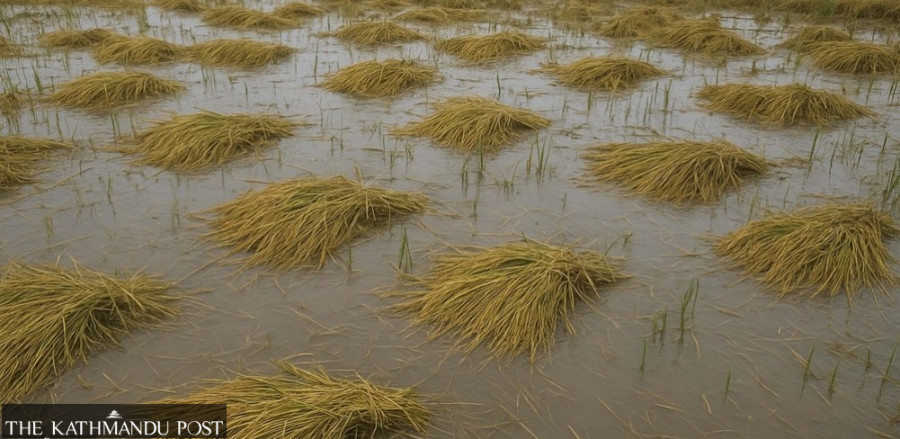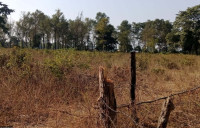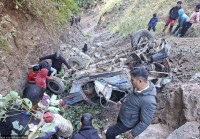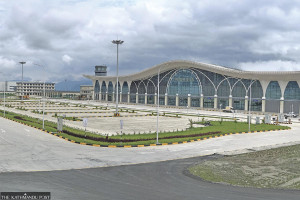National
Unseasonal rain soaks ripening paddy in Salyan, farmers fear rot
As farmers attempt to dry the drenched harvest, more losses loom with heavy rain forecast in the coming days due to Cyclone Montha’s impact.
Biplab Maharjan
Unseasonal rain that started from Monday night has submerged harvest-ready paddy crops across Salyan, leaving farmers very worried about possible losses. Meteorologists have forecast more rain in the coming days, compounding fears that paddy left to dry in the fields could rot or sprout.
According to the Agriculture Knowledge Centre in Salyan, around 7,000 hectares of land in Salyan, a hill district of Karnali province, are cultivated with paddy each year. Over half of this season’s crop had already been harvested. But ripe paddy which has been reaped and left to dry in various fields of Sharada, Bagchaur and Bangad Kupinde municipalities, Tribeni, Kalimati, Siddhakumakh, Kumakh and Darma rural municipalities was drenched by the continuous rains.
“Most of us had delayed harvesting, thinking we’d collect the paddy after celebrating Dashain and Tihar,” said Deepak Bhandari, a farmer of Kalimati Rural Municipality. “We had already cut and spread it in the fields to dry, but the unexpected rain soaked everything. In some areas, the fields are completely submerged.”
Bhandari said that even though the rain stopped by Wednesday morning, cloudy weather has made it difficult to dry the soaked paddy. “We’ve started moving the grain to drier spots, but we’re worried if it can still be used as seed for next year,” he added.
Similar concerns were shared by Krishna Budhathoki, a farmer from ward 5 of Tribeni. “Many of us had planned to thresh the paddy using machines, but the rain came before we could bring them to the fields,” he said. “If the rainfall continues, we could lose most of our harvest. The last time we had this kind of untimely rain after Dashain, our paddy was ruined.”
Farmers complain that they lack a proper place to store the harvested grain. “My harvested paddy was soaked for more than 24 hours,” said Bhim Bahadur Nepali of ward 9 of Sharada Municipality. “Now it’s hard to dry, and much of it has already sprouted or fallen apart.”
Unseasonal rainfall during the harvest period has become more frequent in recent years, damaging crops across the country. Experts attribute these erratic weather patterns to climate change and shifting monsoon cycles.
Mahesh Acharya, chief of the Agriculture Development Office in Salyan, said the damage might be limited. “Most farmers have already harvested their crops. The remaining paddy near seasonal streams and unirrigated terraces may have been affected, but since most farmers here grow hybrid varieties, a single day of rainfall may not cause significant losses,” he said.
Still, for smallholders who depend on their harvest for household consumption, even partial losses could be devastating. “The grain we produce is what feeds our families for six months. If this rain ruins it, we’ll be in trouble until the next harvest,” said Bhandari.
The ongoing rain and snowfall, triggered by westerly winds caused by a depression in the Arabian Sea—which has affected Karnali, Lumbini, Gandaki, Bagmati provinces and hilly areas of Koshi province—is expected to lessen from Wednesday. However, the effects of Cyclone Montha that developed in the Bay of Bengal and made landfall in India’s Andhra Pradesh on Tuesday evening will start in Nepal from Thursday, experts say.
Very heavy rainfall, similar to that during the Dashain festival in the first week of October, is most likely to occur again from Thursday, with Koshi and Madhesh provinces expected to be hit hardest, meteorologists have warned. Over 50 people died, scores were injured, and thousands were displaced due to floods and landslides triggered by torrential rains in the first week of October. Authorities then enforced restrictions on vehicular movements to prevent further mishaps.




 20.12°C Kathmandu
20.12°C Kathmandu















